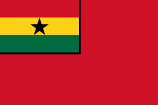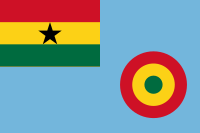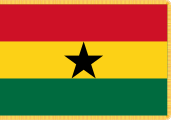Flag of Ghana
The national flag of Ghana was designed and adopted in 1957 and was flown until 1962. It was then reinstated in 1966. It consists of the Pan-African colours of red, gold, and green, in horizontal stripes, with a black five-pointed star in the centre of the gold stripe. The Ghanaian flag was the second African flag after the flag of the Ethiopian Empire to feature these colours. The flag's design influenced that of the flag of Guinea-Bissau (1973). The flag of Ghana was designed by Theodosia Okoh (1922–2015).[1][2]
 | |
| Use | National flag and state ensign |
|---|---|
| Proportion | 2:3 |
| Adopted | 1957 28 February 1966 (readoption) |
| Design | A horizontal triband of red, gold, and green, charged with a black star in the centre |
| Designed by | Theodosia Okoh |
 Variant flag of Ghana | |
| Use | Civil ensign |
| Proportion | 2:3 |
| Design | A red field with the national flag, fimbriated in black, in the canton |
 Variant flag of Ghana | |
| Use | Naval ensign |
| Proportion | 2:3 |
| Design | Red St. George's Cross on white centrrensign, with the national flag in canton. |
The red represents the blood of those who died in the country's struggle for independence from Great Britain, the gold represents the mineral wealth of the country, the green symbolises the country's rich forests and natural wealth, and the black star is the symbol of African emancipation.[3][4] The black star was adopted from the flag of the Black Star Line, a shipping line incorporated by Marcus Garvey that operated from 1919 to 1922.[5] It is where the Ghana national football team derive their nickname, the "Black Stars".
National ensign
Under terms of section 183 of Ghana's Merchant Shipping Act of 1963, the civil ensign is a red flag with the national flag in a black-fimbriated canton. In 2003, a new merchant shipping act was enacted, however, and this simply provides that "the National Flag of Ghana" is the proper national colours for Ghanaian ships. No mention is made of other flags or other possible flags.
The naval ensign is a red St. George's Cross on white flag, with the national flag in canton.
Air force ensign and civil air ensign
 The ensign of the Ghana Air Force
The ensign of the Ghana Air Force The Ghanaian civil air ensign
The Ghanaian civil air ensign
The Ghana Air Force has its own ensign that incorporates the flag of Ghana. Civil aviation in Ghana is represented by the national civil air ensign. It is a standard light-blue field with the Ghanaian flag in the canton. It is charged in the fly with either a red, yellow and green roundel (in the case of the military ensign) or black five-pointed star (in the case of the civil ensign). Both have been used since Independence in 1957, and the subsequent founding of the Ghana Air Force in 1959.
History
 Flag of the Kingdom of Ashanti, eventually absorbed into the Gold Coast.
Flag of the Kingdom of Ashanti, eventually absorbed into the Gold Coast..svg.png) Flag of the Gold Coast, the forerunner to Ghana. Used until 1957.
Flag of the Gold Coast, the forerunner to Ghana. Used until 1957..svg.png) First flag of the Union of African States with Guinea, used between 1958 and 1961.
First flag of the Union of African States with Guinea, used between 1958 and 1961..svg.png) Second flag of the Union of African States, used between 1961 and 1964 (after Mali joined).
Second flag of the Union of African States, used between 1961 and 1964 (after Mali joined)..svg.png) Ghana national flag (1964–66).
Ghana national flag (1964–66). Flag of the Presidency of Ghana since 1966. Presidential Standard of Ghana; replicate of the national flag of Ghana with a gold rim.
Flag of the Presidency of Ghana since 1966. Presidential Standard of Ghana; replicate of the national flag of Ghana with a gold rim.

The Ghanaian government flag, adopted in 1957, was flown until 1962. Similarly, when the country formed the Union of African States, the flag of the Union was modeled on Bolivia's flag, but with two black stars, representing the nations. In May 1959, a third star was added.
Following the January 1964 constitutional referendum, Ghana adopted a variant of the 1957 tricolour with white in the place of yellow, after the colours of Kwame Nkrumah's ruling and then-sole legal party Convention People's Party, making it similar to the flag of Hungary. The original 1957 flag was reinstated on February 1966 following Nkrumah's overthrow in a coup d'état.
References
- "Mrs Theodosia Okoh: The Woman Who Designed The Ghanaian Flag", African Celebs.
- Mrs. Theodosia Salome Okoh Profile at GhanaWeb.
- "Flag of Ghana: The Meaning of the Flag", GhanaWeb.
- "Theodosia Salome Okoh, Ghana’s Illustrious Daughter", Flex Newspaper, 29 January 2017.
- Crampton, William George (1993). "Marcus Garvey and the Rasta colours". Report of the 13th International Congress of Vexillology, Melbourne, 1989. Flag Society of Australia. pp. 169–180. ISBN 0-646-14343-3.
External links
| Wikimedia Commons has media related to Flags of Ghana. |